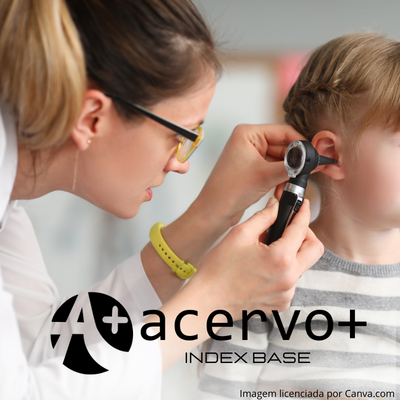Análise das imprecisões diagnósticas na conduta da otite média aguda: uma revisão integrativa da literatura
##plugins.themes.bootstrap3.article.main##
Resumo
Objetivo: Compreender as dificuldades no diagnóstico e tratamento da otite média aguda e buscar entender os perigos decorrentes da imprecisão deste diagnóstico no atendimento das crianças. Métodos: Este estudo realizou pesquisas nas plataformas National Library of Medicine (PubMed) e SciELO, priorizando trabalhos dos últimos 10 anos, 2010 a 2020. O aumento da delimitação temporal nas bases de dados foi necessário devido à dificuldade de se encontrar artigos recentes sobre o tema exposto. Sendo selecionados 23 artigos. Os descritores foram “Otitis media”, “Diagnosis,” “Otorhinolaryngology” e “Drug Resistance”. Resultados: Baseado nesses dados evidenciou-se a existência de uma imprecisão diagnóstica e terapêutica na OMA das crianças. Esta conclusão é suportada diretamente pelas análises de 5 autores e indiretamente pela análise dos demais aqui analisados. Todos afirmam que: a OMA é de difícil diagnóstico; é uma doença comum e natural nas crianças e autolimitada na maioria das vezes; há um uso excessivo e desnecessário de antibióticos; há uma imprecisão diagnóstica generalizada dos profissionais de saúde. Considerações finais: Os profissionais estão aptos para identificar e tratar adequadamente a doença, mas os cursos de formação ainda precisam se estruturar melhor para evitar imprecisões diagnosticas no futuro e se conscientizarem sobre o uso indiscriminado de antibióticos.
##plugins.themes.bootstrap3.article.details##
Copyright © | Todos os direitos reservados.
A revista detém os direitos autorais exclusivos de publicação deste artigo nos termos da lei 9610/98.
Reprodução parcial
É livre o uso de partes do texto, figuras e questionário do artigo, sendo obrigatória a citação dos autores e revista.
Reprodução total
É expressamente proibida, devendo ser autorizada pela revista.
Referências
2. BRANDILEONE MC, et al. Effect of 10-valent pneumococcal conjugate vaccine on nasopharyngeal carriage of Streptococcus pneumoniae and Haemophilus influenzae among children in Sao Paulo, Brazil. Vaccine, 2016; 34(46): 5604-5611.
3. DICKSON G. Acute otitis media. Prim Care, 2014; 41(1): 11-8.
4. FERNÁNDEZ-FEIJÓO CD, et al. Antibiotic prescribing in a paediatric emergency department. An Pediatr (Barc), 2010; 73(3): 115-20.
5. GADDEY H, et al. Otitis Media: Rapid Evidence Review. Am Fam Physician, 2019; 100(6): 350-356.
6. GREVERS G. Challenges in reducing the burden of otitis media disease: an ENT perspective on improving management and prospects for prevention. Int J Pediatr Otorhinolaryngol, 2010; 74(6): 572-7.
7. GRUBB MS, SPAUGH DC. Treatment failure, recurrence, and antibiotic prescription rates for different acute otitis media treatment methods. Clin Pediatr (Phila), 2010; 49(10): 970-5.
8. HARMES KM, et al. Otitis media: diagnosis and treatment. Am Fam Physician, 2013; 88(7): 435-40.
9. HOBERMAN A, et al. Shortened Antimicrobial Treatment for Acute Otitis Media in Young Children. New England Journal of Medicine, 2016; 375(25): 2446–2456.
10. ISAACSON G. Acute Otitis Media and the Crying Child. Pediatr Infect Dis J., 2016; 35(12): e399-e400.
11. KALU SU, et al. Clinical spectrum of acute otitis media complicating upper respiratory tract viral infection. Pediatr Infect Dis J., 2011; 30(2): 95-9.
12. KAUR R, et al. Epidemiology of Acute Otitis Media in the Postpneumococcal Conjugate Vaccine Era. Pediatrics, 2018; 141(3): e20174067.
13. KOIVISTO JN, CHONMAITREE TMT. Importance of viruses in acute otitis media. Curr Opin Pediatr, 2015; 27(1): 110-5.
14. LIEBERTHAL AS, et al. The diagnosis and management of acute otitis media. Pediatrics, 2013; 131(3): e964-99.
15. MARCHISIO P, et al. Medical education and attitudes about acute otitis media guidelines: a survey of Italian pediatricians and otolaryngologists. Pediatr Infect Dis J, 2010; 28: 1-4.
16. MOUSSEAU S, et al. Diagnosing acute otitis media using a smartphone otoscope; a randomized controlled trial. The American Journal of Emergency Medicine, 2018; 01: 093.
17. PENIDO NO, et al. Complications of otitis media: a potentially lethal problem still present. Braz J Otorhinolaryngol, 2016; 82: 253-62.
18. PICHICHERO ME, CASEY JR. Diagnostic inaccuracy and subject exclusions render placebo and observational studies of acute otitis media inconclusive. Pediatr Infect Dis J., 2018; 27(11): 958-62.
19. PICHICHERO ME, POOLE MD. Comparison of performance by otolaryngologists, pediatricians, and general practioners on an otoendoscopic diagnostic video examination. Int J Pediatr Otorhinolaryngol, 2015; 69: 361-6.
20. PILTCHER OB, et al. How to avoid the inappropriate use of antibiotics in upper respiratory tract infections? A position statement from an expert panel. Braz J Otorhinolaryngol, 2018; 84: 265-79.
21. RETTIG E, TUNKEL DE. Contemporary concepts in management of acute otitis media in children. Otolaryngol Clin North Am, 2014; 47(5): 651-72.
22. SÁFADI MA, JAROVSKY D. Acute otitis media in children: a vaccine-preventable disease? Braz J Otorhinolaryngol, 2017; 83: 241-2.
23. STEVANOVIC T, et al. Acute otitis media: to follow-up or treat? Int J Pediatr Otorhinolaryngol, 2010; 74(8): 930-3.

